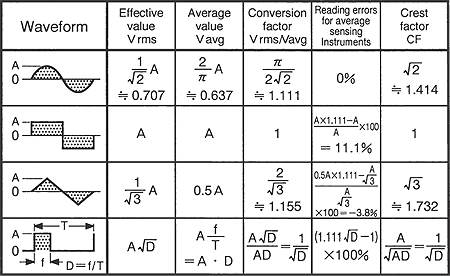True RMS value
Most alternating currents and voltages are expressed in effective values, which are also referred to as RMS(Root-Mean-Square)values. The effective value is the square root of the average of the square of alternating current or voltage values.
Many clamp meters with rectifier type circuits have scales that are calibrated in RMS values for AC measurements. But, they actually measure the average value of input voltage or current, assuming the voltage or current to be a sine wave.
The conversion factor for a sine wave, which is obtained by dividing the effective value by the average value, is 1.1. These instruments are in error if the input voltage or current has some other shape than a sine wave.

CF : Crest Factor = Peak value/RMS value
DC = 1
Sine wave = 1.414
What is the True RMS Value?
The True RMS (Root Mean Square) value is a mathematical measure of the effective value of an alternating current (AC) or voltage waveform. Unlike the simple average or peak values, the RMS value gives a more accurate representation of the power or energy delivered by the waveform, regardless of its shape (sinusoidal, square, triangular, etc.). It is often used in electrical engineering to determine the heating effect or power dissipation in resistive loads.
Why is the True RMS Value important?
-
Accurate Power Calculations:
The RMS value is crucial for determining the true power delivered to a load. Power calculations based on the RMS voltage or current are more accurate, especially for non-sinusoidal waveforms. -
Energy Dissipation:
The RMS value represents the equivalent DC voltage or current that would produce the same amount of heat or energy dissipation in a resistor as the actual AC waveform. This is important for calculating energy loss in electrical devices. -
General Application:
In real-world applications, AC signals are rarely perfect sinusoidal waveforms. The True RMS value ensures that power calculations and measurements are accurate, even for complex, distorted, or irregular waveforms.
When should the True RMS Value be used?
The True RMS Value should be used in the following situations:
-
For Non-Sinusoidal Waveforms:
If the waveform is distorted or non-sinusoidal (e.g., a square wave, triangular wave, or any irregular signal), the True RMS value should be used to calculate accurate power dissipation or energy. -
When Measuring Power in AC Circuits:
True RMS measurements are essential when measuring power in circuits where the voltage or current is not purely sinusoidal. This is common in systems that involve rectifiers, inverters, or switching power supplies. -
In Electrical and Electronics Testing:
When testing or measuring electrical devices, instruments like True RMS multimeters are used to accurately measure the voltage or current values, particularly in environments with noisy or distorted waveforms. -
For Heating and Energy Calculations:
The True RMS value is used to calculate the amount of energy a circuit or component will dissipate as heat. This is important for selecting proper components that can handle the power without overheating.


Search for Calculator
Explore thousands of free calculators trusted by millions worldwide.